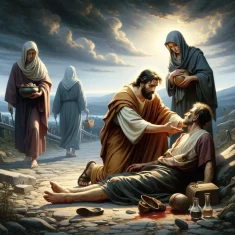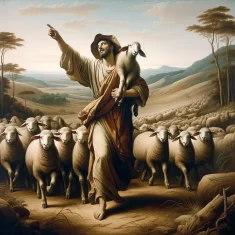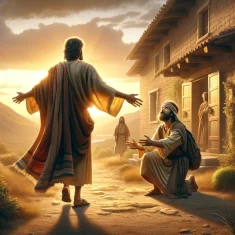
A scenic depiction of a sower scattering seeds on various types of ground, including a path, rocky ground, among thorns, and on good soil.
In the heart of the Gospels, Jesus communicates profound truths through simple, vivid stories known as parables. These narratives, rich with meaning, reveal the kingdom of God, illustrate moral lessons, and offer insights into the nature of God’s love and mercy. Through farmers, servants, lost sons, and good Samaritans, Jesus speaks to the human condition, inviting all to reflect and transform.
The Parable of the Sower
The Parable of the Sower, as presented in the biblical narratives, offers a profound allegory about the nature of receptivity and spiritual growth. At its core, this parable delves into the metaphor of seeds falling on different types of ground, each representing the condition of our hearts and minds towards the word of God. It is a narrative that masterfully intertwines the simplicity of agricultural life with deep spiritual truths, shedding light on the dynamic interplay between divine grace and human freedom.
The sower in the parable goes out to sow seeds indiscriminately, which fall upon varied terrains: the path, rocky ground, among thorns, and on good soil. This act of scattering seeds without regard to the type of ground reflects the universality of God’s call to humanity. It underscores the notion that the divine message is offered to all, without distinction, inviting every individual to partake in the spiritual journey.
However, the parable reveals that the efficacy of this call is contingent upon the receptiveness of the heart. The seeds that fall on the path are quickly taken away, symbolizing those who hear the word but do not internalize it. The seeds on rocky ground sprout rapidly but lack depth, representing fleeting enthusiasm for the spiritual message that withers in the face of adversity. The seeds among thorns grow but are choked by life’s cares and distractions, illustrating how worldly concerns can overshadow spiritual growth. Finally, the seeds on good soil flourish, emblematic of those who hear, accept, and nurture the word, leading to abundant spiritual fruitfulness.
This diverse outcome highlights the crucial role of personal response in the spiritual journey. It calls for introspection and self-awareness, urging individuals to cultivate their hearts, making them fertile ground for spiritual growth. The parable serves as a reminder that while the divine message is freely given, its transformational power in our lives depends significantly on our openness and willingness to engage with it deeply.
The Parable of the Sower, therefore, resonates through the ages as a timeless reflection on the dynamics of faith and the human condition. It challenges us to examine the state of our own hearts and to be mindful of how we receive and nurture the spiritual truths sown in our lives. Through this parable, we are invited to embark on a journey of growth and transformation, encouraged by the promise of flourishing that comes from embracing the word of God with a receptive and committed heart.
The Parable of the Good Samaritan

Illustrates a compassionate Samaritan tending to a wounded man by the roadside while two other figures pass by in the background. The Samaritan is depicted as offering aid and comfort, highlighting the themes of mercy and neighborly love.
The Parable of the Good Samaritan, as recounted in the Gospels, serves as a powerful narrative that disrupts conventional understandings of kinship, compassion, and moral obligation. In this story, Jesus crafts a scenario that not only challenges the societal norms of his time but also offers timeless insights into the nature of genuine altruism and neighborly love.
Set against the backdrop of a question posed to Jesus about who qualifies as one’s neighbor, the parable unfolds with a man falling victim to robbers on a treacherous road. As the story progresses, it is not the religious elite or the culturally respected who come to the aid of the wounded man, but a Samaritan—a figure traditionally viewed with suspicion and disdain by the Jewish audience to whom Jesus spoke. This deliberate choice of hero in the narrative upends the listeners’ expectations and prejudices, compelling them to reconsider the bounds of compassion and community.
The Samaritan’s actions, characterized by unwavering kindness and generosity, encapsulate the essence of compassion. By providing for the injured man’s needs without hesitation or expectation of reciprocation, the Samaritan exemplifies the kind of unconditional love that transcends societal divisions and cultural animosities. This figure becomes a model of how to act not out of obligation or for recognition but from a place of deep empathy and humanity.
Jesus’ parable, therefore, is not merely a call to show kindness to those within one’s immediate circle or of similar background but an invitation to extend mercy and assistance to all, irrespective of differences. It challenges the audience to expand their understanding of community and to recognize the inherent value and dignity in every individual. The story asserts that the true measure of neighborly love lies in the willingness to act beyond conventional expectations and to serve others with compassion and generosity.
The Parable of the Good Samaritan continues to resonate profoundly in contemporary discourse, serving as a reminder of the power and importance of acting with kindness and mercy in a divided world. It calls individuals and communities alike to look beyond superficial differences and to embrace a more inclusive and unconditional approach to compassion, thereby fostering a society where everyone is seen and treated as a neighbor.
The Parable of the Lost Sheep

Shows a shepherd in ancient attire joyfully carrying a sheep on his shoulders, surrounded by a vast landscape. The rest of the flock can be seen in the background, symbolizing the rejoicing over one sinner who repents.
The Parable of the Lost Sheep is a poignant illustration of divine compassion and the intrinsic value of each individual in the eyes of the divine. Through the simple yet profound story of a shepherd who leaves his ninety-nine sheep to search for the one that is lost, Jesus conveys the depth of God’s love and the extent to which it will go to recover a single lost soul.
This narrative is set against the backdrop of pastoral life, where the loss of even one sheep can be keenly felt by the shepherd. The shepherd’s determination to find the lost sheep, despite having many others, highlights the immeasurable value placed on every single life. The joy and celebration upon finding the lost sheep underscore the theme of redemption and the importance of repentance. It reflects a God who is not indifferent to the plight of the individual but is actively seeking out those who are lost, offering them a way back into the fold.
The message of the Parable of the Lost Sheep is multifaceted. On one level, it reassures individuals of their worth and the unwavering love that pursues them, encouraging those who feel lost or disconnected to return to a place of safety and belonging. On another level, it challenges the community of believers to adopt the shepherd’s perspective, valuing each person and recognizing the significance of each life. It calls for a compassionate outreach to those who are struggling, marginalized, or have strayed from their path, emphasizing that mercy and love should be extended to all, without reservation.
Moreover, the parable is a testament to the joy in redemption, both for the individual and for the community. The shepherd’s rejoicing upon finding the lost sheep is a powerful image of the celebration that occurs in the divine realm over one sinner who repents. It serves as a reminder of the transformative power of forgiveness and the renewal that comes through grace.
In essence, the Parable of the Lost Sheep invites reflection on the nature of divine love, the value of individual souls, and the call to embody compassion in our interactions with others. It affirms the worth of every person and the importance of extending a hand to those in need, mirroring the shepherd’s commitment to seek out and rejoice in the return of the lost.
The Parable of the Prodigal Son

A touching scene where a father embraces his returning son, who looks worn and repentant. In the background, the older brother watches, and the family home can be seen, symbolizing forgiveness and the joy of reconciliation.
The Parable of the Prodigal Son stands as a timeless narrative that resonates deeply with readers across cultures and generations. At its core, this parable serves as a poignant illustration of forgiveness and the transformative power of reconciliation. Through the experiences of the wayward son, the loving father, and the faithful brother, it imparts profound lessons about the nature of unconditional love, redemption, and the joy that accompanies restoration.
Central to the parable is the character of the prodigal son, whose reckless behavior leads him down a path of self-destruction. Driven by greed and impatience, he demands his inheritance prematurely, squandering it in a distant land on indulgent living. However, as he finds himself destitute and broken, he experiences a moment of clarity—an awakening to the depths of his folly and the longing for home.
In his journey back to his father’s house, the prodigal son embodies the themes of humility and repentance. Despite his waywardness and shame, he humbles himself before his father, acknowledging his mistakes and seeking forgiveness. His return symbolizes a turning point—a decisive step towards reconciliation and a new beginning.
The father’s response to his son’s return epitomizes the boundless love and mercy that defines the divine relationship. Instead of condemnation or reproach, the father’s heart overflows with compassion and joy at the sight of his lost son’s homecoming. His embrace is a symbol of unconditional acceptance, a tangible expression of forgiveness that transcends any wrongdoing.
Equally significant is the reaction of the elder brother, whose resentment and self-righteousness reveal another dimension of the human condition. While the prodigal son is welcomed with open arms, the elder brother struggles to reconcile his sense of justice with his father’s lavish display of grace. His bitterness underscores the challenges inherent in extending forgiveness and embracing reconciliation—a reminder of the complexities of the human heart.
Ultimately, the Parable of the Prodigal Son underscores the transformative power of forgiveness and the joy that accompanies reconciliation. It challenges us to confront our own capacity for grace and mercy, urging us to emulate the boundless love of the Father. Through the prodigal son’s journey of repentance and return, we are reminded of the inherent worth of every individual and the profound depth of God’s love—a love that eagerly awaits our homecoming, no matter how far we may have strayed.